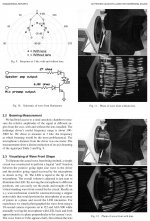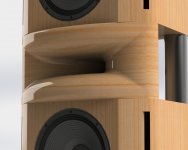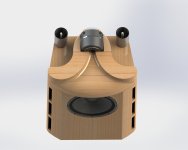Look at this design, is there any enlightenment coming in you mind ?
Enlightenment versus my mind...? Not since Aristotle

Enlightenment versus my mind...? Not since Aristotle
Here is a commercial product called Sonic Industrial Imager :
Fluke ii900 Sonic Industrial Imager, 1280 x 800
Like this.
Thanks to Winston Kock, we can see the soundwaves since 1950.
https://www.amazon.fr/Seeing-Sound-Winston-Kock/dp/047149710X
Last edited:
A friend of mine worked in a club that had those. He said that even with earplugs they ripped his head off. He couldn't stand it.How many of us would expect to endure considerable SPL at about 1-2 meters distance from either bunch of horns without earplugs?
Fortunately for me, I've only seen them, not heard them.

I have that Winston Kock book around here somewhere.
Two things I have not seen discussed thoroughly;
I've seen it commented about the high end quality of a large horn....since when did horn size impede on sound quality of the treble? Sound quality being that which is pertaining to signal reproduction and not pertaining to how wide of dispersion pattern.
Second, why would a large horn beam any more than a small horn of the same design, say large jmlc vs small jmlc...of course the pattern would contain more frequencies within the directive spectrum of the horn but the beaming of the treble....why wouldn't that be identical...this aspect is governed by the exit size, is it not? If both horns have a 1.5" exit then the beaming should be identical as well, if not.....why not.
I've seen it commented about the high end quality of a large horn....since when did horn size impede on sound quality of the treble? Sound quality being that which is pertaining to signal reproduction and not pertaining to how wide of dispersion pattern.
Second, why would a large horn beam any more than a small horn of the same design, say large jmlc vs small jmlc...of course the pattern would contain more frequencies within the directive spectrum of the horn but the beaming of the treble....why wouldn't that be identical...this aspect is governed by the exit size, is it not? If both horns have a 1.5" exit then the beaming should be identical as well, if not.....why not.
Last edited:
Don't honk if you're horny...

It's a radial horn, similar to those of Arai/TAD/Vitavox/Yuichi etc.
If Joseph Crowe were to inflate his ES-800 to an ES-300, it would be about the size of the G.I.P. 9712 (excluding his roundovers).
I actually will be involved in a project where the ES-300 Biradial will be used for customer's speaker. The Yuichi A-290 was originally slated for the design but they've opted to use the ES-300 instead. I've not built this size yet so it will be very interesting to see how it performs. The decision was based on the ES-1200 and ES-800's measured performance. The chosen compression driver will the TAD TD-4001. We are fairly certain this will be the best chance of obtaining wide coverage in the upper treble but there's no way to know until the horn is actually built.
Attachments
Very nice looking Joseph!
I asked before, does anyone have any polars of these large bi-radials? How do you go about formulating the curves?
I asked before, does anyone have any polars of these large bi-radials? How do you go about formulating the curves?
Last edited:
Two things I have not seen discussed thoroughly;
I've seen it commented about the high end quality of a large horn....since when did horn size impede on sound quality of the treble? Sound quality being that which is pertaining to signal reproduction and not pertaining to how wide of dispersion pattern.
Second, why would a large horn beam any more than a small horn of the same design, say large jmlc vs small jmlc...of course the pattern would contain more frequencies within the directive spectrum of the horn but the beaming of the treble....why wouldn't that be identical...this aspect is governed by the exit size, is it not? If both horns have a 1.5" exit then the beaming should be identical as well, if not.....why not.
There are some narrowing when you go to a larger throat. Here is a summary of the horizontal coverage width at 17kHz for the horns I build...
1" throat: 90 degrees
2" throat: 75 degrees (based on interpolation)
3" throat: 60 degrees
However I also tested the B&C ME20 Constant Directivity horn for comparison which uses a 1" throat...
1" B&C ME20: 30 degrees
So as you can see if the horn flare geometry does not facilitate wide coverage then it will quite easily cause a narrowing in the upper treble.
That is my point, a lager horn does not beam more, a larger exit size does, unless I'm mistaken of course. I'm also talking of horns of the same design style as well.
That is correct. At least with my horn geometry if I try to remove the rolled lip on the horn mouth then the upper treble (17kHz) will narrow from 60 degrees down to around 35 degrees. I’ve essentially made the horn smaller and yet the upper upper treble coverage suffered.
A friend of mine worked in a club that had those. He said that even with earplugs they ripped his head off. He couldn't stand it.
Fortunately for me, I've only seen them, not heard them.
There's quite a few iterations of those and like all PA installations, the end result largely depends on implementation and application.
The club I was referring to is located in a small yard cellar from the 17th century, yet there are 4 Tri Motion units flown around the dancefloor + a number of Air Motions as infills. So there's ample headroom available. As a result, each of these units doesn't need to generate high output levels to adequately fill this space with music. I expect these barely exceed 100dB each and the low levels of distortion positively affect sound quality. At least, they definitely didn't rip my head off.
The main issue with the bunch of horns is probably related to lobing, some kind of interference between each of the 3 horns, or reflections which makes the sound muddy.
Last edited:
That is correct. At least with my horn geometry if I try to remove the rolled lip on the horn mouth then the upper treble (17kHz) will narrow from 60 degrees down to around 35 degrees. I’ve essentially made the horn smaller and yet the upper upper treble coverage suffered.
Your 'royal roundovers' seem to act like a mouth extension, somewhat similar to those invented by Keele for the EV HR-series. Bigger is (almost) always better.
That is my point, a lager horn does not beam more, a larger exit size does, unless I'm mistaken of course. I'm also talking of horns of the same design style as well.
Above a certain frequency and dependent on the design of the phase plug, a driver will start to beam at about the same frequency with 2 differently sized horns of the same type. For a classic round horn this frequency is related to a point along the horn at which the wavelength becomes too small to 'see' the hornwall. As the wavefront in a JMLC, Tractrix, Expo or similar round horn increasingly narrows with frequency, there's no distinct 'point of beaming'. However, in the polars a frequency can be distinguished above which there's no additional narrowing - roughly between 8-15kHz.
Last edited:
One solution to eliminate or reduce beaming would be a phasehorn, a phaseplug having channels that extend into horn 'segments'...
Another: a modified Berstis lens, in which phaseplug and horn are combined.
Another: a modified Berstis lens, in which phaseplug and horn are combined.
Last edited:
camplo, your reasoning is correct, at least wrt round horns, like your JMLCs
"A larger horn does not beam more, a larger exit size does"
"A larger horn does not beam more, a larger exit size does"
One solution to eliminate or reduce beaming would be a phasehorn, a phaseplug having channels that extend into horn 'segments'...
Another: a modified Berstis lens, in which phaseplug and horn are combined.
Surprised the Smith horn concept isn't more popular.
GM
Maybe it is because it is using diffraction. I once heard a Smith horn with a 4" midrange and it was really great (it was the Danish JealVox system).
Not long ago I heard a Smith horn with the BMS 4592. It sounded much better than expected. Sounded nice enough that I was going to build a pair, but ended up using my BMS drivers on multicell.
- Home
- Loudspeakers
- Multi-Way
- Is it possible to cover the whole spectrum, high SPL, low distortion with a 2-way?


